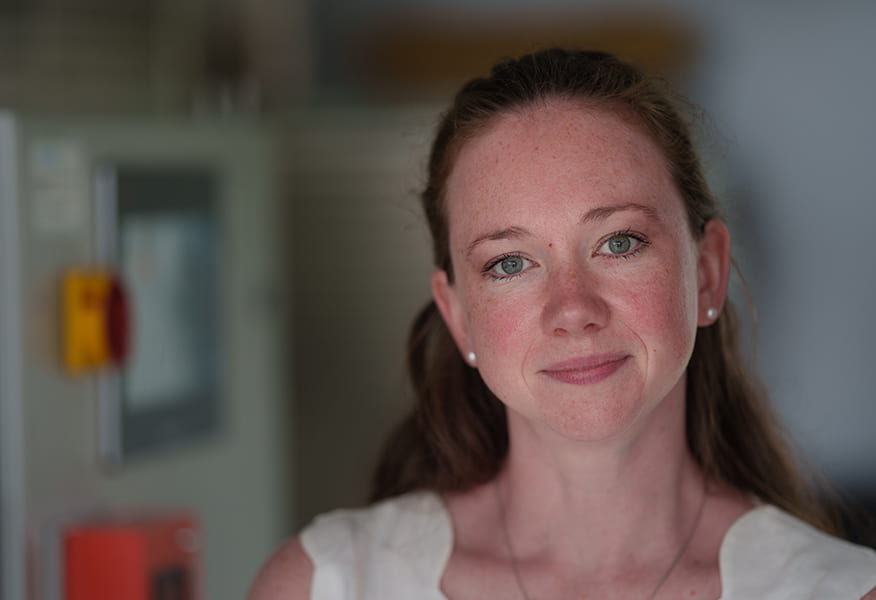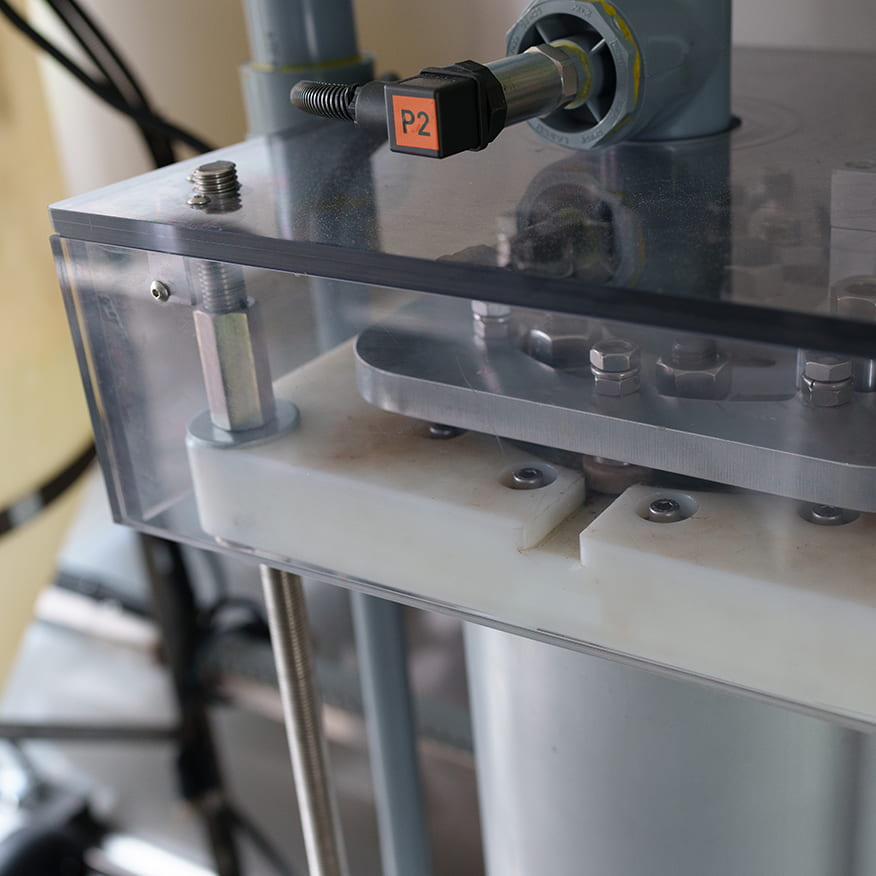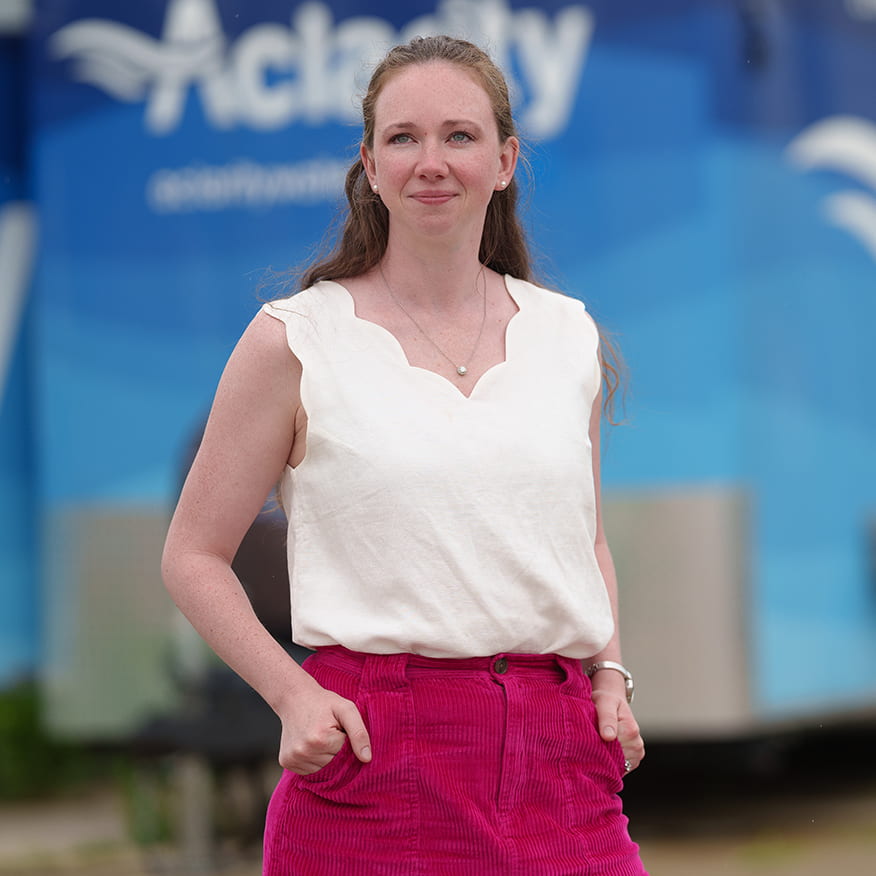ChatGPT: Revolutionary Tech or Pandora’s Box?
Is ChatGPT a tool to be embraced—disruptive in a good way—or something to be feared as a profound risk to society and humanity.
Read StoryJulie Bliss Mullen ’12 uses electrochemistry to sever the nearly unbreakable bond in PFAS forever chemicals.
Per- and polyfluoroalkyl substances, more concisely known as PFAS, are a group of some 14,000 synthetic chemicals that include a chain of carbon and fluorine atoms with a bond that is nearly unbreakable. First patented in the 1930s, they have had a wide variety of uses, including in adhesives, concrete, detergents, cosmetics, automotive finishes, electronics, ammunition, medical devices, firefighting foam, and even violin strings. The original formulation of Teflon, which still coats nonstick cookware in kitchens around the world, was based on PFAS, as was the original version of the blockbuster stain repellant Scotchgard.
This nearly unbreakable bond is what makes PFAS useful in such a wide variety of applications—but it’s also why these chemicals are a slow-brewing environmental disaster.
By the 1990s, accumulating evidence showed that exposure to PFAS poses health risks, including cancer, immune system disruption, and developmental issues in children. In 2001, the U.S. Environmental Protection Agency (EPA) published a health advisory for two common types of PFAS, perfluorooctanoic acid and perfluorooctane sulfonate. Although over the next two decades many manufacturers phased out the use of PFAS, the chemicals have persisted in the environment, where they continue to pose a danger to people and wildlife. They don’t biodegrade, they aren’t broken down by solvents or sunlight, and they can remain in our bodies for years—in short, they seem to live up to their common nickname, “forever chemicals.”
But nothing really lasts forever. And that’s what Julie Bliss Mullen ’12, the driven founder of a start-up called Aclarity, is aiming to prove.
A Safe Drinking Water Obsession
Mullen first started thinking about PFAS the summer after her sophomore year at WPI, when the dual environmental engineering and environmental and sustainability studies major began an internship with the Boston office of the EPA, focusing on drinking water safety.
“At that time, PFAS were considered a ‘contaminant of emerging concern,’ in drinking water,” Mullen says. “There was still not a lot known, but we all knew that these were forever chemicals, that they don’t degrade, and standard treatment technologies don’t do anything to destroy them. Even something as complex as UV and ozone and some of the more advanced treatment technologies didn’t touch them.”

Until recently, the only way to deal with PFAS in drinking water was to absorb it with activated carbon or ion exchange resins, resulting in solid, PFAS-encrusted chunks that had to be disposed of in a landfill. There, however, the chemicals continue to cause harm by seeping out with leachate, a rather evocative term-of-art for the rainwater that percolates through a landfill, absorbing pollutants before draining into the environment.
“That leachate comes out, it’s discharged right into the sewer or the river, it goes into the oceans, it gets into the groundwater, and now you have this massive problem,” says Mullen, who would gradually become obsessed with safe water as she continued her education.
With WPI’s chapter of Engineers Without Borders, Mullen traveled to Guatemala, where her team developed rooftop water-harvesting systems for a rural community that had previously relied on a single, seasonal well. She devoted her MQP to researching PFAS, and after graduation she returned to the EPA as an environmental engineer while taking graduate classes at WPI. A National Science Foundation Graduate Research Fellowship allowed her to begin working toward a PhD in civil and environmental engineering at the University of Massachusetts Amherst, and it was there that she discovered a promising solution that would change the course of her career.

At UMass, Mullen was focusing on electrochemical oxidation, researching different types of electrodes as she investigated the technology’s potential to remove contaminants from water. She developed a water treatment system that sent a current through water, and she hoped it might work as a commercial product for use in homes. With the encouragement of her advisors and the entrepreneurship office at UMass, she filed a patent.
“We thought, and now we have confirmed, that we had found something that no other researcher or anybody else had found before,” Mullen says.
“The technology generates oxidants, essentially really strong chemicals that break down compounds. I was originally thinking this would be for bacteria and viruses, but this was producing really strong oxidants, the kind that can break down things like volatile organic compounds, pharmaceuticals, and pesticides—and some of the other so-called ‘contaminants of emerging concern’—all the stuff that I was working on when I was at the EPA.”
She suspected the technology would also prove a powerful weapon against PFAS, and as she continued to work on the tech, Mullen began to consider what to do with it. She was on track for a successful career in academia, but she also craved the satisfaction of having an immediate impact on a real-world problem. A lifetime in the lab seemed unlikely to offer that.
A start-up, on the other hand, might.
Taking the Leap
Mullen grew up in a working-class family in Uxbridge, Mass., 20 minutes and a world away from WPI. Her father is an auto mechanic and her mother is a waitress. She was encouraged to explore the world and pursue higher education as the first in her family to go to college, let alone pursue a PhD. In high school, she had been active on the student council, the environmental science club, and the dance team, and when it came time to apply to college, her primary ambition was to find a likeminded community: people who were passionate, studious, and engaged, and who wanted to make an impact in the world.
Entrepreneurship, on the other hand, was an idea that came later—surprising even Mullen herself as she considered her future post-WPI.
“I think research is really important because it drives solutions,” she says. “But I knew I didn’t want to be at the bench all the time. I wanted to take something innovative and do something meaningful with it.”
I think research is really important because it drives solutions. But I knew I didn’t want to be at the bench all the time. I wanted to take something innovative and do something meaningful with it.
Half a decade later, she had her innovation. The next step would be more of a leap.
“For a while, I was afraid to talk about starting a company even with my classmates at UMass, because I thought that people would just think that I wasn’t focusing on my PhD,” Mullen says. “There can be a stigma even for filing a patent, because a patent doesn’t actually count toward your PhD.”
But despite her own hesitation, and the fact that it would make publishing her research more difficult, her advisor, David Reckhow, urged her to pursue commercialization. She started by taking a business course in “customer discovery,” which gave her confidence that there was a market for electrochemical water purification. Then, in 2017, she participated in a campus-wide pitch challenge. She won first place, with a prize of $26,000.
“That, at the time, was huge,” she says, “because now I had the opportunity to build something and really test it out and take it to trade shows and potential customers. After I won that prize, I formally incorporated the company.”
Soon afterward, Mullen decided to leave her PhD program and focus full-time on building the business she had named “Aclarity,” pitching it to investors, perfecting the tech, and assembling a talented team.
“She was focused, and she knew—that always impressed me—what she could offer to the industry,” says WPI trustee Judy Nitsch ’75, Hon. ’15, who was paired with Mullen through the Trustee Mentor Program in 2011 and has remained a confidant. Nitsch started her own business, Boston-based Nitsch Engineering, Inc., in 1989, at a time when women founders were rare, and grew it into a nationally recognized, 110-person firm before she retired in 2020. While she wasn’t familiar with Mullen’s specific field, Nitsch was a ready source of business advice, encouraging Mullen as she pursued her dream of starting a viable company.

“She was doing a lot of pitches, so I did talk with her about how to present yourself, to have answers to potential questions already prepared,” Nitsch remembers. “And obviously she has done that, because look at how successful she is! But I really can’t remember her not being confident. She didn’t hesitate to make pitches when she was eight months pregnant. This is the reality of entrepreneurs today, and she did it with gusto.”
The Challenges of a Start-up
In the years since she founded Aclarity, Mullen, who holds the title of CEO, has built a team of about a dozen full-time employees, including several WPI alumni. Employees are required to have not only strong technical skills, she says, but also “the internal drive to solve really big problems. We’re a start-up, and with that there are new challenges every day, so we all step in and help each other out.”
Crucially, Aclarity has demonstrated to the market that it can indeed sever the nearly unbreakable carbon-fluorine bond that gives “forever chemicals” their name at full-scale. It now has more than 30 clients, including manufacturers, water engineering firms, and landfills. Aclarity’s system can eliminate PFAS in concentrations as low as a few parts per trillion, but because treating a concentrated waste stream is the most efficient way to address PFAS, the team often finds itself dealing with leachate, a thoroughly disgusting substance that, Mullen says, looks and smells like the filthy water that might accumulate in the bottom of a dumpster—but much worse.
“From an environmental impact standpoint, though, it’s so important, because about 50 percent of PFAS in the environment is in landfills, and 28% of that comes out in the leachate,” Mullen says. “We’re actually removing that forever from the environment, breaking the PFAS cycle.”
The first step in tackling a new source of PFAS contamination involves deploying an Aclarity mobile trailer, with a pump, power supply, myriad pipes and valves, and a single full-scale reactor. (The reactor is about the size of a water cooler; permanent installations include a set of eight.) Inside the trailer is a mobile laboratory with a touchscreen monitor that allows Aclarity to track amperage, voltage, pressure, temperature, and flow rate, which is typically between one-half and two gallons per minute.
We’re actually removing that forever from the environment, breaking the PFAS cycle.
“Basically, leachate goes into storage tanks and then we pull up our trailer and plug the hose right into a tank and pump the water through the reactor,” Mullen explains. “We pump it through, the PFAS is destroyed, and then we pump it right out into another tank. The data from the pilot helps us see what the permanent, full-scale system is going to look like for that site. And it’s really cool when you’re on site and you see this raw leachate go through, then come out—and it’s a lot cleaner. You can see it has much more of a yellow-to-clear tint to it, as opposed to this dark black color.”
The company now has clients across Massachusetts and as far away as Virginia and New Mexico. Mullen still visits every site, suiting up in a hardhat, safety vest, boots, and safety glasses to walk her clients through Aclarity’s process. At least half her time recently has been devoted to pitching investors across the United States and around the world. In June the company closed on a Series A venture capital fundraising round. That better positioned Aclarity to take advantage of the expanding PFAS destruction market, which was valued by BlueTech Research at close to $4 billion.
“The investors that are coming in this round are from all around the globe,” she notes.
Mullen is married to a fellow WPI alum, Daniel Mullen, with whom she has a toddler and a preschooler. When not on the road, she often works from home, which allows her to combine busy work days and late nights with family time.
“We have two or three solid hours with our kids every day, and we try to make that time really count, but it’s definitely hard to not be with them as often as I feel like we should be,” she says, noting that it can be especially difficult when she has to travel. To make it more fun for the kids, Mullen always takes one of their stuffed animals with her on business trips, snapping photos to send back home so they can see the adventures their animal friend is having.
Balancing things can be hectic, but Mullen’s children are also an important reminder of why she works hard to rid the world of PFAS, chemicals that threaten the health of children everywhere, and of the environment they stand to inherit.
“Being away from them is always tough, but I do have to remember what I’m doing,” she says. “We have made this technology economic and deployed it in the field, and we’re leading the way to permanently destroy PFAS—forever! Someday, my kids will be old enough to understand what that means for all of us.”
Awesome! What a great story and mission
U Maine has been looking for a PFAS solution as I’m sure many others are. It is in the Bangor daily news almost every day. This is a top priority for the State. I hope your sales effort is in touch.
This is amazing! Congratulations Julie (as well as to your support network)!
Now that a method to destroy PFAS in our drinking water has been proven, under the precautionary principle, will water utilities be liable if they don’t use it?
Congrats! This news should be on the front page of the New York Times
What are the limits to scalability? This article describes an opportunity to rectify a huge intersectional injustice. What would it take to process this landfill? How can we help?
https://wisconsinwatch.org/2023/10/wisconsin-alabama-toxic-pfas-firefighting-foam-cleanup-landfill/